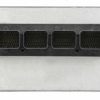Is Your GM Truck or SUV Stalling, Hesitating, or Not Starting?
If you’re experiencing frustrating fuel delivery issues with your 2007-2009 GM vehicle, you’re not alone. Symptoms like engine stalling, hesitation during acceleration, an extended crank time, or a complete no-start condition can often be traced back to a single, critical component: the Fuel Pump Control Module (FPCM). This module, also known as a Fuel Pump Driver Module, is the brain behind your vehicle’s fuel pump, and when it fails, it can leave you stranded. This listing is for a direct-replacement FPCM, part number 15213110, that arrives at your door fully programmed to your vehicle’s specific VIN, providing a true plug-and-play solution.
From the Diagnostic Bay
We had a 2008 Silverado 1500 towed in with a classic ‘crank, no start’ complaint. The owner had already replaced the fuel pump himself, assuming it was the obvious culprit, but the truck still wouldn’t fire up. He was frustrated and had spent money on a part he didn’t need. After connecting our scan tool, we found code P069E – ‘Fuel Pump Control Module Commanded OFF’. We checked power and ground at the module, which were good. We then commanded the fuel pump on with the scan tool and got nothing. The issue wasn’t the pump; it was the brain telling it what to do. The original FPCM, mounted on the frame rail, had corroded and failed internally. We installed a new, VIN-programmed module, and the truck fired up on the first try. This is a story we see play out week after week, highlighting the importance of correctly diagnosing the FPCM before condemning the in-tank pump.
Understanding the Role of Your GM Fuel Pump Control Module
In modern GM vehicles, the fuel pump doesn’t just run at full speed all the time. To improve efficiency and reduce wear, the Engine Control Module (ECM) sends a signal to the GM Fuel Pump Control Module, which then precisely regulates the voltage and speed of the fuel pump. This ensures the engine receives the exact amount of fuel it needs under all conditions, from idling at a stoplight to accelerating onto the highway. Because of its location—typically mounted to the vehicle’s frame rail—the FPCM is exposed to harsh conditions like water, salt, and road debris, which often leads to corrosion and premature failure.
Common Symptoms of a Failing FPCM
- ✔ Engine Stalling: The engine may stall unexpectedly while driving or after coming to a stop, often with no warning.
- ✔ No-Start Condition: The engine will crank over but will not start due to a lack of fuel pressure.
- ✔ Hesitation or Stumbling: Under acceleration, the vehicle may hesitate or feel like it’s losing power as the module fails to command the correct fuel pump speed.
- ✔ Check Engine Light: A failing FPCM will often trigger the Check Engine Light with specific diagnostic trouble codes (DTCs).
- ✔ Reduced Power Mode: The vehicle may enter a ‘limp mode’ or display a ‘Reduced Engine Power’ message on the dash.
- ✔ Inconsistent Fuel Gauge Readings: In some cases, a faulty module can interfere with fuel level sensor signals.
- ✔ Common Trouble Codes: P069E, P0230, P025A, U0109.
The Plug-and-Play Advantage: No Dealer Visit Required
Replacing a GM Fuel Pump Control Module isn’t just a matter of swapping the part. A new module from the dealership or a generic parts store is essentially a blank box; it must be professionally programmed with GM-specific software to communicate with your vehicle’s other computers. This traditionally requires a trip to a dealership or a high-end repair shop with expensive scan tools and software subscriptions. Our solution eliminates that entire process. By providing us with your vehicle’s VIN during checkout, you receive a module that has been loaded with the latest GM software and calibrated specifically for your truck or SUV. This makes the installation as simple as unbolting the old module and plugging in the new one, saving you significant time, money, and hassle.
This module is a direct replacement for a wide range of popular GM vehicles and is compatible with the following part numbers: 13501024, 15213110, 20759945, 20850907, 25785013, 25854536, 25866052, and 25967325. Please verify fitment for your specific make and model before ordering.
Frequently Asked Questions
Do I need to program this module?
No. The main benefit of our service is that we program the module for you before it ships. Simply provide your 17-digit VIN, and the part will arrive ready for a plug-and-play installation.
Where is the FPCM located on my vehicle?
On most GM trucks and SUVs from this era (like the Silverado, Tahoe, Yukon, and Express), the FPCM is mounted to the driver’s side frame rail, often near the spare tire. On other models, its location can vary, so it’s always best to consult a service manual for your specific vehicle.
What are the most common trouble codes for a bad FPCM?
The most common codes are P069E (Fuel Pump Control Module Commanded OFF) and U0109 (Lost Communication With Fuel Pump Control Module). You may also see codes like P0230 (Fuel Pump Primary Circuit Malfunction) or P025A (Fuel Pump Module Control Circuit/Open).
Is this better than a used module from a salvage yard?
Absolutely. A used module will be programmed to a different vehicle and will not work in yours without being reprogrammed. Furthermore, our modules are loaded with the latest software updates from GM, which often correct factory flaws, and you’re getting a reliable part not pulled from a potentially damaged vehicle.
What information do you need from me to program it?
We only need your vehicle’s 17-digit Vehicle Identification Number (VIN). You can typically find this on your driver’s side dashboard (visible through the windshield), on the driver’s door jamb sticker, or on your vehicle’s registration and insurance documents.



